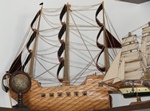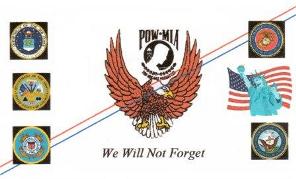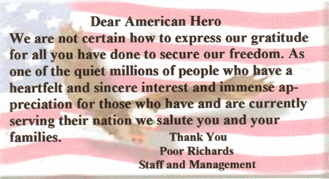The History

The building Poor Richards occupies today was built in 1902.
The building on the northeast corner of Crosstown and Mill Street, known today as Poor Richards Café, was built in 1902. It was one big room which is known today as the ‘A’ side (where the main counter and cash register are). We do not know who the first occupants of the building were, but in the teens and twenty’s during Prohibition the building was know as the Night Owl Bar. When it was the Night Owl Bar there was a gas station across the street but otherwise it was fields. Richard’s dad and uncle used to ride their bikes down from the north side, hide their bikes in the weeds, and then lie in the weeds across the street and watch the goings on at the bar. The Night Owl was a fairly nice place but once it turned dark in the neighborhood – watch out. The Night Owl Bar is mentioned in two different gangster books. The street level was about six or eight foot lower than it is now. They had about a dozen steps that went from the street down to the bar. Several years ago, when the city was working on the street, one of their engineers showed Richard exactly how far down the original road was. Richard went down in the hole and saw it and got some of the old street bricks to keep as a souvenir. There were two different levels of street brick, from two layers of road, so he got some of each. The whole area from Mill Street to the Kalamazoo River and over to Portage Street was a big city landfill. They had to build the buildings up high enough back then so that they would not get flooded out when the river flooded.
The ‘B’ side (the next section to the north) was built during prohibition sometime. The ‘B’ side is where Taylor Electric started and that’s who the old phone board down in the basement was for. When Taylor Electric moved out in the 1940’s Davis Electronics moved in. In 1948 – the back side (east) was added and a 2-bay truck repair shop opened up. This business lasted less than 2 years. In the beginning of 1950 they turned it into a restaurant – that’s why the windows were so big on the front, and on February 5, 1950 the Corner Café opened. The Corner Café lasted until 1967 when it turned into the H & H Café (Howard and Hazel).
During all this time Richard was working for the Railroad and commuting back and forth from his apartment in Chicago to his family here on the weekends. Richard and the family had looked at purchasing a house near Calumet City but decided not to purchase it and keep the family in Michigan. Richard came back to Kalamazoo shortly after that but continued to work for the railroad. In 1977 Richard purchased Mr. Don’s on the corner of North and Douglas. Richard was working for the railroad yet but every night he would go check on the restaurant, which could have gotten him fired because it would have been a breach of contract. Back then the north side was mainly college housing and frat houses and college kids were his main source of money at Mr. Don’s. Richard and Sue started having problems because of all the hours he was working so he sold it on land contract in 1981. The people that purchased it only stayed in business a few months, stopped making the land contract payments to the bank and filed bankruptcy, however no one had told Richard. A friend of Richards called and told him that a foreclosure notice had been put on the back door of the building. The bank wanted the property for themselves and that is why they had not told Richard that his buyer was nine months behind on his payments. Richard offered to make three payments a month to catch up but the bank refused.
On February 5, 1985 Richard leased the H & H and changed it to Poor Richards Café. He named it Poor Richards because he was almost broke at the time. The first day they were open a man on a motorcycle stopped in and bought a cup of coffee just to see what it was like inside. That was the only customer they had on opening day, remember, the H & H Café had a bad reputation. Richard did not want his wife, Sue, working down at the restaurant at first because he knew she would not like the situation, that is, no customers. Richard was open Monday through Friday six a.m. to one p.m. Richard had $17 left in his bank account and felt the business was about to go under when he had an idea. He had his waitress, under protest, take a plate of food and walk it around the restaurant so that people could see it because all the customers were ordering was coffee and toast. The following Monday, for no reason that they can think of, business just started to boom. Richard was cooking at the time and he had one waitress. He decided to open up on Saturdays too. Richard had about three or four guys that he used to work with on the railroad that were loyal customers. They would come down every day and would bring their families on the weekends.
Richard was leasing the building at first but when President Reagan changed some of the business laws Richard decided to make an offer to purchase the building. He took a piece of yellow paper, ripped a part of it off and put the offer in with his rent money. Richard offered his landlord $30,000 to purchase the building. Klose electric had offered $35,000 to purchase it years earlier. About four months after he had done this, his landlord pulled up in a Mercedes convertible one day and told Richard that he would accept his offer. He asked Richard if his attorney was going to handle the whole thing. Richard said yes, and that was that. In 1987-88 Richard expanded to the ‘A’ side because it was empty. From the very first day he opened the ‘A’ side it filled up. He had people lined up from the front door around the corner past the side door waiting to get in for lunch. Soon Richard talked to Ted Davis of Davis Electronics about ‘B’ side. He acquired ‘B’ side and in 1991. Richard opened ‘B’ side after lots of hard work and cleaning up because Davis Electronics had left lots of stuff behind. In the meantime Richard needed a new roof and he could not afford one. He had gotten many quotes and thrown the roofing people off the roof a couple times because of that. Bill Orwright was owner of the roofing company that was trying to do the roof. Finally one day he sent three huge guys up on the roof and, as usual Richard climbed up the ladder ready to kick them off. They met him before he could get to the top and told him he had better go talk to their boss. Richard went right to the roofing company (off Lake St) and told him that he could not afford it. Bill asked him what his lowest bid was and Richard told him it was $1280. He then asked Richard what the highest bid was and Richard told him it was $18,000. Bill told Richard he would split the difference and he did it for $8,000. Bill also told Richard to pay him what he could when he could whether is was a penny or several hundred dollars, until it was paid off. Every time it rained they could put out 50 buckets or more on the floor because the roof was so bad. So Richard got his new rubber roof.
What made Richard start the ships and all the other collectibles? A regular customer had recently lost her husband. She had an estate sale, yard sales and had not really sold anything. One day she invited Richard to come see if she had anything he would like to buy. Richard and Sue went and looked through everything. Richard found a set of National Geographic magazines that he liked and he found a ship that took his interest. Even thought he did not really want the ship, he bought it and the magazines and they gave her fifty dollars for all of it. Richard put the ship on a shelf at the restaurant because he did not really know what to do with it. One day an antique dealer came in and he offered Richard $2500 for it. It’s the one with the handmade sails. That’s all it took. After that Richard went to antique places to find ships and whatever else he could find that would go with them. Richard went down by Coldwater to a little town called
Homer and found the matchstick ship. He found a few more items to go with the matchstick ship and took it all down to the register and wanted to know what the manager wanted for it. Richard said he would have paid $500 for the ship but the man charged him $35 for everything. Richard asked the man if he had a box to put everything in. The man was gone about fifteen minutes but finally came back with a box and Richard drove it carefully home.
Richard decided that he enjoyed doing this. One time he headed up to Traverse City to go to the casino. He had cut off the main road up by Baldwin because he had decided to take a back road that he thought might be a shorter route. He saw an antique barn, drove past it about 4 or 5 miles, turned around and went back. He was looking for brass plates. The lady did not have any but called someone she knew who she thought had some and Richard ended up across the Mackinac Bridge looking for them. He had lost track of time and did not even realize how far he was from home. He had gone from place to place looking and never even ended up going to the casino.
In 1996 Richard built on the backside (north) of the building and they ended up with ‘C’ side. Both ‘B’ and ‘C’ were non-smoking. Today the whole restaurant is non-smoking.


